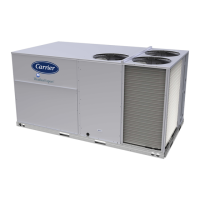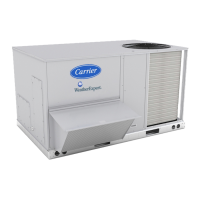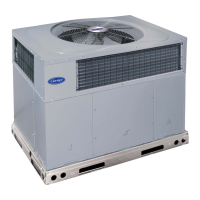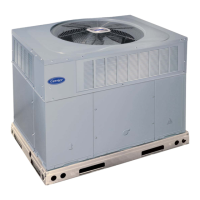24
(HEAT 2 RELAY), power is supplie d to the se cond st age of the ma in
gas val ve. If both st age 1 and stage 2 of the gas val ve cl ose, gas wil l
be turned off to t he ma i n burners.
Supply Air Tempering
Supply Air Tempering control operates the gas or electric heat to
maintain a minimum supply air temperature during conditions
where very cold outdoor air causes the supply air temperature to
fall below the configured Supply Air Tempering Setpoint. This
occurs during periods where DCV is active and increasing the
amount of outdoor air or in cases where the system is operating at
very low airflow and the calculated economizer position has
increased to maintain a constant ventilation rate.
The user can enable/disable Supply Air Tempering.
The following conditions must be true for the supply air tempering
algorithm to operate:
S The SA Tempe r ing is set to Yes (OKTOSATEMPER=YES)
S The indoor fan is on
S The System Mode is in Vent (Ventilation or Supply Fan Only) or
IAQ Override.
S The Outdoor Air Temperature < Minimum Cooling SAT 48_F.
S Heat type is gas or electric and Number Of Heat Stages > 0
If all the above are true, the SystemVut controller will monitor the
SAT sensor value and operate the first stage of heat to temper the
supply air as required in order to maintain the configured SA
Tempering Setpoint
Economizer Operation
The Economizer is used for ventilation, and cooling. If the Indoor
fan is not on, the economizer will not operate. If an economizer is
installed, then Economizer Installed (ECON INSTALLED = YES)
should be set to YES. The unit produces a 4 --20mA signal which is
then changed to a 2 -- 10V signal with a 500 ohm resistor, which can
control the economizer actuator. The economizer output signal is
displayed by the Economizer Commanded Position (ECON CMD
POSITION). The actuator’s built-- in 2 to 10VDC feedback signal
is read in as an analog input to know the actual position which is
displayed as Economizer Actual Position (ECON ACT
POSITION).
Minimum Ventilation
The economizer will open to allow ventilation when the indoor fan
is turned on and the unit is in the occupied state. The economizer
damper position at any given time for ventilation is displayed as
the Min Position in Effect (EFFECTIVE MIN POS).This
minimum position can be effected by the indoor fan speed (F.SPD)
and indoor air quality. To maintain a constant airflow through the
economizer, as the indoor fan speed decreases or increases the
damper minimum position will increase or decrease, respectively.
This relationship curve is shown in Fig. 19.
NOTE: The software point names are used in Fig. 19 as to not
clutter the graph. These points are not individually set and
therefore only visible from a network for troubleshooting.
These units can also be equipped with optional CO
2
sensors for
additional indoor air quality control. When unit is equipped with a
return duct CO
2
sensor or return duct CO
2
sensor and outside air
CO
2
sensor the Economizer minimum position vs. fan speed curve
will be recalculated based on the CO
2
level of the return and/or
outside air as shown in Fig. 19. When performing Demand
Controlled Ventilation, the damper’ s Min Position in Effect
(EFFECTIVE MIN POS) will operate in the shaded area of Fig.
19 based on the IAQ Level (IAQ) and the Commanded Fan Speed
(IDF SPEED OUTPUT). See the Indoor Air Quality (IAQ)
section for more details on Demand Controlled Ventilation (DCV).
The damper position curve can be field adjusted per application if
needed.
1. Activate test mode to control the fan and dampers to
achieve the correct numbers.
2. Set the fan speed for the maximum amount needed for
design CFM requirements. This should also be the IDF
maximum Fan speed (MAXIMUM IDF SPEED).
3. Open the damper to the position which satisfies the highest
ventilation requirement running maximum fan speed, and
then set the Economizer minimum at maximum fan speed
(MIN POS @ MAX FAN) to this damper position.
4. Set the fan speed to a realistic operating speed in the upper
range, and then set the User Minimum Position Speed 1
(MIN POS SPEED 1) equal to that speed. This should be
somewhere in the 80% range.
5. Open the damper to the position which satisfies the highest
ventilation requirement running speed 1 fan speed, and then
set the User Minimum Position Damper Position 1 (MIN
POS DAMP 1) to this damper position.
6. Set the fan speed to a realistic operating speed in the mid--
range, and then set the User Minimum Position Speed 2
(MIN POS SPEED 2) equal to that speed. This should be
somewhere in the 60% range.
7. Open the damper to the position which satisfies the highest
ventilation requirement running speed 2 fan speed, and then
set the User Minimum Position Damper Position 2 (MIN
POS DAMP 2) to this damper position.
8. Set the fan speed to a realistic operating speed in the low--
range, and then set the User Minimum Position Speed 3
(MIN POS SPEED 3) equal to that speed. This should be
lowest fan speed in planned operating range.
9. Open the damper to the position which satisfies the highest
ventilation requirement running speed 3 fan speed, and then
set the User Minimum Position Damper Position 3 (MIN
POS DAMP 3) to this damper position.
The shape of the curves in Fig. 19 are determined by the
configuration parameters: User Minimum Position Speed 1 (MIN
POS SPEED 1), User Minimum Position Damper Position 1
(MIN POS DAMP 1), User Minimum Position Speed 2 (MIN
POS SPEED 2), User Minimum Position Damper Position 2
(MIN POS DAMP 2), User Minimum Position Speed 3 (MIN
POS SPEED 3), User Minimum Position Damper Position 3
(MIN POS DAMP 3), and Economizer minimum at maximum fan
speed (MIN POS @ MAX FAN). These configurations are preset
at the factory of default purposes. The Economizer minimum at
maximum fan speed (MIN POS @ MAX FAN) should be changed
based on the air balance of the unit for proper ventilation.
The user adjustable points discussed above are defaulted to zero
from the factory which forces the control to use a set of default
points. The default points should not be left for permanent
operation, as it may cause inadequate ventilation. Economizer
minimum at maximum fan speed (MIN POS @ MAX F AN) and at
least one set of user points User Minimum Position Speed 1 (MIN
POS SPEED 1) and User Minimum Position Damper Position 1
(MIN POS DAMP 1) should be used to create a linear curve to
cover the broad scope of fan operation.
Free Cooling
The economiz e r wil l be ena bl ed for cooling (OK TO FREE COOL?
=Yes)i f the suppl y air tem per ature sensor reading is vali d, the re are
no appl ied loc kouts, and economizer is operationa l. Economi zer
Operational (ECON OPERATIONAL?) indicates if an econom izer is
installed (ECON INSTALLED?) and feedback indicates it is
operational. The three econom i zer lockouts tha t determine if fr ee
cooling should be used t o hel p with cooli ng are: Dry Bulb Lockout
(DRY BULB LOCKOUT), Enthal py Lockout (ENTHALPY
LOCKOUT), and Unocc upied Fre e Cooling Loc kout (UFC
LOCKOUT?). Any one of the se loc kouts will dis able economizer free
cooling. See below for how each lockout occ urs.

